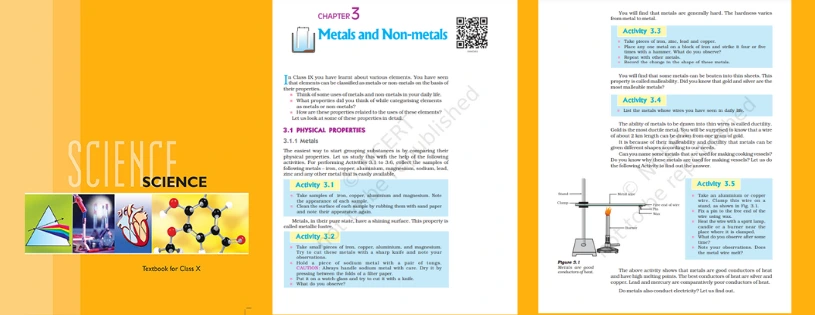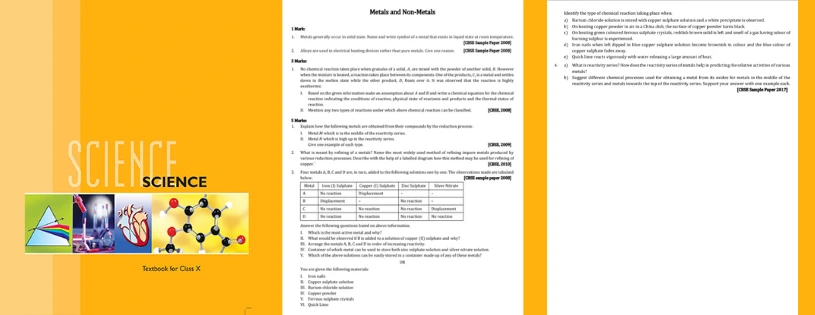Welcome to an enriching journey into the captivating realm of Metals and Non-metals, where knowledge meets convenience! In this exploration, we bring you a unique opportunity to delve into the intricacies of these fundamental elements with the aid of CBSE NCERT resources. The CBSE NCERT Download serves as your gateway to a comprehensive understanding of Metals and Non-metals, ensuring a seamless and enriching learning experience. Let's embark on this educational voyage, unlocking the mysteries of these essential components that shape the world around us.
Unlocking the World of Metals and Non-metals: CBSE NCERT Download for Comprehensive Learning
Metals, with their distinctive properties, are integral to various aspects of our daily lives. Some key characteristics of metals include:
-
Conductivity: Metals are excellent conductors of heat and electricity. This property makes them essential in the manufacturing of electrical wires, circuits, and various electronic devices.
-
Malleability and Ductility: Metals can be hammered into thin sheets (malleability) and drawn into thin wires (ductility) without breaking. This property is utilized in industries such as construction and metallurgy.
-
Luster: Metals often have a shiny appearance due to their ability to reflect light. This characteristic adds to the aesthetic appeal of many metal objects.
-
High Melting and Boiling Points: Metals generally have high melting and boiling points, contributing to their stability in various applications.
Common examples of metals include iron, copper, aluminum, and gold. Each metal has unique properties that make it suitable for specific purposes, ranging from construction to jewelry.
Non-metals: Versatility in Nature
In contrast to metals, non-metals encompass a diverse group of elements with distinct characteristics. Some notable features of non-metals include:
-
Poor Conductivity: Non-metals are generally poor conductors of heat and electricity. This property makes them suitable for insulating materials.
-
Brittleness: Unlike metals, non-metals are often brittle and can break or crumble easily. This characteristic is crucial in understanding their applications in various industries.
-
Dull Appearance: Non-metals lack the luster associated with metals and often have a dull or matte appearance.
-
Lower Melting and Boiling Points: Non-metals typically have lower melting and boiling points compared to metals, influencing their use in various processes.

Physical Properties of Metals
● Hard and have a high tensile strength – Carbon is the only non-metal with very high tensile strength.
● Solid at room temperature – One non-metal, bromine, is a liquid at room temperature. The other non-metals are solids at room temperature, including carbon and sulfur.
● Sonorous – Metals produce a typical ringing sound when hit by something.
● Good conductors of heat and electricity – Graphite is a good conductor of heat and electricity.
● Malleable, i.e., can be beaten into thin sheets
● Ductile, i.e., can be drawn into thin wires
● High melting and boiling points (except Caesium (Cs) and Gallium (Ga)) – Graphite, a form of carbon (a non-metal), has a high boiling point and exists in a solid state at room temperature.
● Dense (except alkali metals). Osmium – highest density, and lithium – least density
● Lustrous – Metals have the quality of reflecting light from their surface and can be polished, e.g., gold, silver and copper. Iodine and carbon are non-metals which are lustrous. Note that carbon is lustrous only in certain forms like diamond and graphite.
● Silver-grey in colour (except gold and copper) – Metals usually have a silver or grey colour.
Non-Metals
Nonmetals are those elements which do not exhibit the properties of metals.
Physical Properties of Non-metals
- Occur as solids, liquids and gases at room temperature
- Brittle
- Non-malleable
- Non-ductile
- Non-sonorous
- Bad conductors of heat and electricity
CBSE Class 10 NCERT Science Topics for a Strong Foundation (NCERT DOWNLOAD)
| Chapter Name | Metals and Non-metals |
| Topic Number | Topics |
| 3.1 | Properties of Metals and Non-metals |
| 3.2 | Reactivity Series |
| 3.3 | Formation and Properties of Ionic Compounds |
| 3.4 | Basic Metallurgical Processes |
| 3.5 | Corrosion and its Prevention |
Chemical Properties
Chemical Properties of Metals
● Alkali metals (Li, Na, K, etc.) react vigorously with water and oxygen or air.
● Mg reacts with hot water.
● Al, Fe and Zn react with steam.
● Cu, Ag, Pt, and Au do not react with water or dilute acids.
Reaction of Metals with Oxygen (Burnt in Air)
A metal oxide is formed when metals are burned in the air and react with oxygen in the air. Metal oxides are a type of basic material found in nature. They change the colour of red litmus to blue. To avoid reactions with oxygen, moisture, and carbon dioxide in the air, sodium and potassium metals are kept in kerosene oil.
Metal + Oxygen→ Metal oxide (basic)
● Na and K are kept immersed in kerosene oil as they react vigorously with air and catch fire.
4K(s)+O2(g)→2K2O(s) (vigorous reaction)
● Mg, Al, Zn, and Pb react slowly with air and form a protective layer that prevents corrosion.
2Mg(s)+O2(g)→2MgO(s) (Mg burns with white dazzling light)
4Al(s)+3O2(g)→2Al2O3(s)
● Silver, platinum and gold don’t burn or react with air.
Basic Oxides of Metals
Metal oxides are crystalline solids that contain a metal cation and an oxide anion. They typically react with water to form bases or with acids to form salts. MO + H2O → M(OH)2 (where M = group 2 metal). Thus, these compounds are often called basic oxides.
Some metallic oxides get dissolved in water and form alkalis. Their aqueous solution turns red litmus blue.
Na2O(s)+H2O(l)→2NaOH(aq)
K2O(s)+H2O(l)→2KOH(aq)
Amphoteric Oxides of Metals
Amphoteric oxides are metal oxides that react with both acids as well as bases to form salt and water.
For example – Al2O3, ZnO, PbO, SnO
Al2O3(s)+6HCl(aq)→2AlCl3(aq)+3H2O(l)
Al2O3(s)+2NaOH(aq)→2NaAlO2(aq)+H2O(l)
ZnO(s)+2HCl(aq)→ZnCl2(aq)+H2O(l)
ZnO(s)+2NaOH(aq)→Na2ZnO2(aq)+H2O(l)
CBSE Class 10 Board Exam Sample Paper

[Previous Year Question Solution Maths Download Button]
[Previous Year Question Solution Science Download Button]
| CBSE CLASS 10 Mathematics Chapters |
| Chapter1: Real Numbers |
| Chapter2: Polynomials |
| Chapter3: Pair of Linear Equations in Two Variables |
| Chapter4: Quadratic Equations |
| Chapter5: Arithmetic Progressions |
| Chapter6: Triangles |
| Chapter7: Coordinate Geometry |
| Chapter8: Introduction to Trigonometry |
| Chapter9: Some Applications of Trigonometry |
| Chapter10: Circles |
| Chapter11: Areas Related to Circles |
| Chapter12: Surface Areas and Volumes |
| Chapter13: Statistics |
| Chapter14: Probability |
| CBSE CLASS 10 Science Chapters |
| Chapter1: Chemical Reactions and Equations |
| Chapter2: Acids, Bases and Salts |
| Chapter3: Metals and Non-metals |
| Chapter4: Carbon and its Compounds |
| Chapter5: Life Processes |
| Chapter6: Control and Coordination |
| Chapter7: How do Organisms Reproduce? |
| Chapter8: Heredity |
| Chapter9: Light – Reflection and Refraction |
| Chapter10: The Human Eye and the Colourful World |
| Chapter11: Electricity |
| Chapter12: Magnetic Effects of Electric Current |
| Chapter13: Our Environment |
| Class 8 |
| Class 9 |
| Class 11 |
| Class 12 |
CBSE Class 10th Downloadable Resources:
| 1. CBSE Class 10th Topic Wise Summary | View Page / Download |
| 2. CBSE Class 10th NCERT Books | View Page / Download |
| 3. CBSE Class 10th NCERT Solutions | View Page / Download |
| 4. CBSE Class 10th Exemplar | View Page / Download |
| 5. CBSE Class 10th Previous Year Papers | View Page / Download |
| 6. CBSE Class 10th Sample Papers | View Page / Download |
| 7. CBSE Class 10th Question Bank | View Page / Download |
| 8. CBSE Class 10th Topic Wise Revision Notes | View Page / Download |
| 9. CBSE Class 10th Last Minutes Preparation Resources (LMP) | View Page / Download |
| 10. CBSE Class 10th Best Reference Books | View Page / Download |
| 11. CBSE Class 10th Formula Booklet | View Page / Download |
Being in CBSE class 10th and considering the board examinations you must be needing resources to excel in your examinations. At TestprepKart we take great pride in providing CBSE class 10th all study resources in downloadable form for you to keep you going.
Below is the list of all CBSE class 10th Downloads available on TestprepKart for both Indian and NRI students preparing for CBSE class 10th in UAE, Oman, Qatar, Kuwait & Bahrain.
FAQ
Q1: What are metals and non-metals?
Ans: Metals and non-metals are two broad categories of elements in the periodic table. Metals are generally characterized by their luster, conductivity, and malleability, while non-metals often lack these properties and are typically insulators.
Q2: How do the physical properties of metals differ from those of non-metals?
Ans: Metals generally have high electrical and thermal conductivity, malleability, ductility, and a characteristic metallic luster. Non-metals, on the other hand, are often poor conductors, brittle, lack luster, and may exist in various states of matter at room temperature.
Q3: What is the electronic configuration of metals and non-metals?
Ans: Metals tend to have one to three electrons in their outermost energy level, making them prone to losing electrons to achieve a stable electron configuration. Non-metals, conversely, have five to seven electrons in their outermost energy level, making them more likely to gain electrons to attain stability.
Q4: How do metals and non-metals react with oxygen?
Ans: Metals generally react with oxygen to form metal oxides, commonly known as rust in the case of iron. Non-metals, on the other hand, form non-metal oxides when they react with oxygen, and these oxides often display acidic properties.
Q5: Provide examples of common metals and non-metals ?
Ans: Examples of metals include iron, copper, aluminum, and gold. Non-metals include elements such as oxygen, nitrogen, carbon, and sulfur.
Leave a Reply